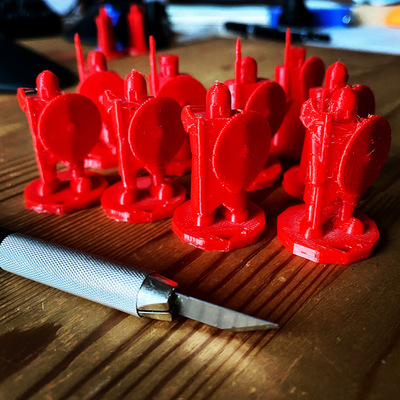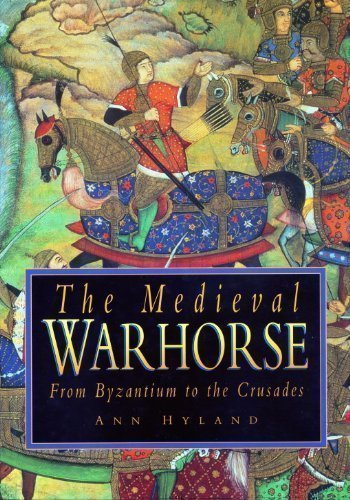
|
The Medieval Warhorse |
| 2022-06-07 |
The Medieval Warhorse

I am in the middle of reading The Medieval Warhorse by Ann Hyland. It is a pleasant read. She is a historian that takes us on a ride in a world were cavalry reigns and where remounts and breeds are strategic.
Here are a few quotes, with reflections they triggered for me interspersed.
The comparison of the stirrup placement over the girth area in Moorish and Persian illustrated texts shows that the Orientals rode short with bent knee and in a more balanced fashion that allowed the leg to absorb some of a thrust's shock. The European rode stiff-legged, locked rigidly in his saddle which was raised so far off the horse's back that no muscle or back movement of the horse could have been felt. The eastern saddle sat closer to the horse and allowed more subtlety in horsemanship and interaction between horse and rider. Feeling a horse's back movement can alert the rider to any impending malicious move by the horse, enabling him to take counteraction and avert a fall.
"Play worlds, not rules" they say. That lets me indulge in history books. In our games, many of us handwave travel and horses.
The earliest mention of the stirrup is in a Chinese source dating to AD 477. It had been developing during the fifth century among the nomads of Siberia and the Altai, especially the Juan Juan (Avars). (...) The shape of a cast-bronze stirrup of Avar type, in the Ashmolean Museum, Oxford, shows superior design, especially in the wide tread which gave security to bowmen as they rose in their stirrups to shoot. Stirrups are first mentioned in Christian literature in Maurice's Strategikon. Gradually they began to appear among different peoples.
Mounted archery, seems ideal to scout and to harass. Gives me ideas of goblin cavalries and parting shots.
Most [Byzantine] cavalry consisted of archers who trained first on foot, then on horseback. They could shoot in either the Roman or Persian manner, that is, using either a thumb lock or a finger release, the former adopted from the Huns. The Hunnic method afforded a faster delivery. Practice was to be carried out on a fast-moving horse, preferably on a route march to conserve the horse's energy, and the rider should shoot both straight ahead and to the rear, both to right and left. Speed and dexterity were vital, the archer being expected to shoot, replace his strung bow in its case, grasp and manipulate the spear carried on his back, replace it, and once again take up his bow. He needed a level-headed horse who did not quicken once the reins were slackened, nor as the rider shifted his position for the various releases. Above all, whether the rider was loosing arrow, lance, javelin or spear, the horse had to keep a straight course, an even pace, and a lowered head and neck to facilitate the rider's aim.
Ok, roll a Ride skill check, and if you succeed, roll for your bow attack...
Here is the horse conquering the West:
In 755 under Pepin I the traditional muster of troops was changed from March to May, indicating that the army was now largely mounted. March grass, even if available, has little food-value. May and June are when grazing is thickest and most nutritious. Three years later, after Pepin defeated the Saxons, he set their tribute at 300 horses per year. By the end of the eighth century the Frankish army was composed mainly of cavalry, and successive monarchs were determined to ensure a steady flow of horses and men by enacting laws compelling all free men to undertake military service. Other laws governed the use and production of horses.
(Pepin I was Mayor of the Palace under the Merovingian king Dagobert I from 623 to 629. Ann Hyland probably refers to Pepin III (the Short) King of the Franks from 751 to 768).
As well as hunting, Charlemagne's court practised war games, showing that for the nobility it was very much an equestrian life. The precursor to the later tournaments was held at Worms in February 842 on the occasion of the Frankish king and the emperor meeting to confirm a treaty. The games took the form of simulated charges, retreats and counter-charges, lances swinging in so disciplined a way that no one got hurt. Note that there is no hint of the couched lance, although the stirrup would by then have been known, event if not universtally adopted. Quite clearly the 'en bloc' charge had already become part of equestrian military skills among the Franks.
I am learning a lot from this book. It focuses on warhorses, but it spans times and locations that bring a lot of variety.
I'd like to find a book about early-medieval and medieval horses and ponies, pack horses, work horses, and war horses, mules and donkeys. I think that it will enrich the setting I present to my players.
Adventure ideas also lurk in the pages of The Medieval Warhorse. Horses are bred and gifted and looked for. Technology is propagated and skills are acquired and polished. Giving the players some horse centered dilemmas might be entertaining.
The book has a two-star review on its goodreads entry, but it's not altogether negative, and reminds us we have to read widely.
comments
Hi. Since you're reading about medieval horsemanship, I thought you may be interested in Jason Kingsley's channel.
Thank you very much! I will explore the content of that channel.
Best regards.
